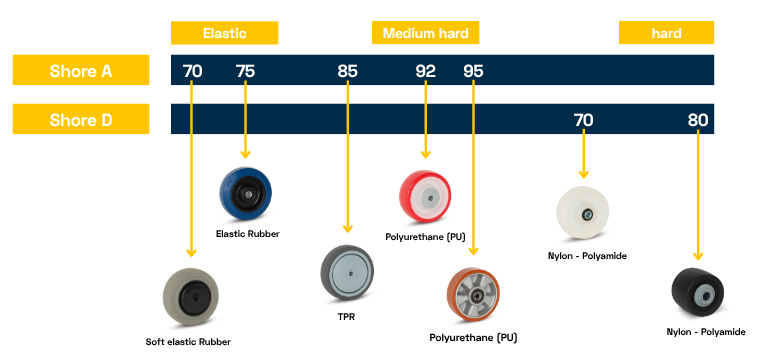
Are you choosing wheels? Then Shore hardness is an important factor to consider. This value indicates how hard or soft the material is and determines how much comfort, noise, and wear resistance you can expect. Each wheel material — whether elastic rubber, PU, or nylon — has its own Shore hardness that defines the wheel’s properties. In this blog, you’ll learn what the values mean, how the hardness of a swivel caster affects usage, and which material best suits your application.
What do Shore A and Shore D mean?
Shore hardness is an international method of measuring the hardness of rubber and plastics. There are two commonly used scales:
- Shore A: for softer materials such as elastic rubber or thermoplastic rubber (TPR).
- Shore D: for hard plastics and technical rubbers, such as nylon and polyamide.
The test is performed with a needle pressed into the material. The deeper the needle penetrates, the lower the score. The scale runs from 0 to 100: the higher the value, the harder the material.
Why is hardness important for wheels?
Take a swivel caster as an example: hardness determines the level of comfort, the amount of noise produced, and how durable the wheel is.
- Soft wheels (low Shore A): comfortable, noise-reducing, and protective for sensitive floors such as laminate, parquet, and PVC.
- Hard wheels (high Shore A or Shore D): wear-resistant, with low rolling resistance, and suitable for heavy loads or rough floors.
If you choose the wrong hardness, it can lead to damaged floors, excessive wear, or an uncomfortable rolling experience.
Overview of materials and their Shore values
The material of a wheel plays a crucial role in its performance. Among different rubber types and alternatives such as PU and nylon, clear differences in Shore hardness can be seen:
- Elastic rubber (approx. 70–75 Shore A): flexible, noise-dampening, and suitable for sensitive floors or outdoor use. See elastic rubber wheels.
- TPR – thermoplastic rubber (approx. 85 Shore A): a balance between comfort and durability, ideal for frequently used indoor floors.
- PU – polyurethane (approx. 92–95 Shore A): hard, wear-resistant, and perfect for heavy loads and intensive use.
- Nylon / polyamide (70–80 Shore D): very hard, low rolling resistance, and suitable for heavy industrial applications.
The chart below shows the Shore hardness per material type:

Application advice by surface type
When selecting wheels, the type of surface is just as important. Here are some guidelines:
- Sensitive indoor floors (wood, laminate, PVC): choose softer Shore A wheels, such as elastic rubber, to avoid scratches and noise.
- Tile or concrete floors: TPR or PU provides a good balance between comfort and durability.
- Heavy industrial applications: use hard PU or nylon wheels (Shore D) that can withstand high loads.
- Outdoor or uneven surfaces: elastic rubber absorbs shocks and provides stability.
Choosing the wheel with the right Shore hardness
The correct Shore hardness depends on the surface, application, and load. Always pay attention to the Shore A and D scales for rubber materials and understand the differences between material types. This way, you avoid floor damage, unnecessary wear, and enjoy longer wheel lifespan.
Would you like tailored advice? Our product specialist will be happy to help you choose the perfect wheel for your situation.

